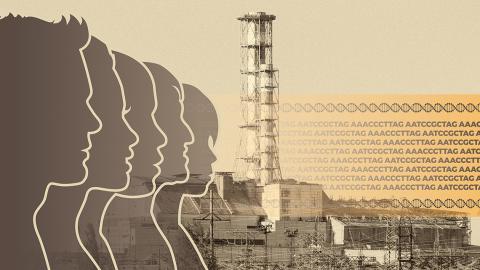International Teams Explore Genetic Effects of Chernobyl

Photo: NCI/istock
In two landmark studies, researchers have used cutting-edge genomic tools to investigate the potential health effects of exposure to ionizing radiation, a known carcinogen, from the 1986 accident at the Chernobyl nuclear power plant in northern Ukraine.
One study found no evidence that radiation exposure to parents resulted in new genetic changes being passed from parent to child. The second study documented the genetic changes in the tumors of people who developed thyroid cancer after being exposed as children or fetuses to the radiation released by the accident.
The findings, published around the 35th anniversary of the disaster, come from international teams of investigators led by NCI researchers. The studies were published online in Science.
The new research uses DNA sequencing and other genomic characterization tools to analyze biospecimens from people affected by the disaster.
In the first study, researchers analyzed the complete genomes of 130 people born between 1987 and 2002 and their 105 mother-father pairs. One or both parents had worked at, or lived close to, the Chernobyl plant. Analyzing the genomes of adult children, researchers found no evidence of an increase in the number or types of de novo mutations—genetic changes transmitted to offspring but not observed in the parents—in their children born between 46 weeks and 15 years after the accident. The findings suggest that the ionizing radiation exposure from the accident had a minimal, if any, impact on the health of the subsequent generation.
“We view these results as very reassuring for people who were living in Fukushima [Japan] at the time of the [nuclear] accident in 2011,” said Dr. Stephen Chanock, director, NCI’s Division of Cancer Epidemiology and Genetics (DCEG). “The radiation doses in Japan are known to have been lower than those recorded at Chernobyl.”
In the second study, researchers sequenced the genetic changes in thyroid cancers that developed in 359 people exposed as children or in utero to ionizing radiation from radioactive iodine (I-131) released by the Chernobyl reactor and in 81 unexposed individuals born more than 9 months after the accident.
Researchers identified the key genes in which alterations enabled the cancers to grow and survive. Nearly all the alterations involved genes in the same signaling pathway. They also identified the types of early genetic changes following exposure to radiation that enabled the growth of thyroid cancers.
The study was made possible by the creation of the Chernobyl Tissue Bank about two decades ago, long before the technology existed to conduct genomic and molecular studies.
Dr. Lindsay M. Morton, deputy chief of the Radiation Epidemiology Branch in DCEG who led the study, said “[Our colleagues in Ukraine] recognized there would be substantial advances in technology in the future, and the research community is now benefiting from their foresight.”
